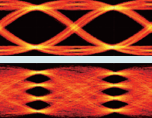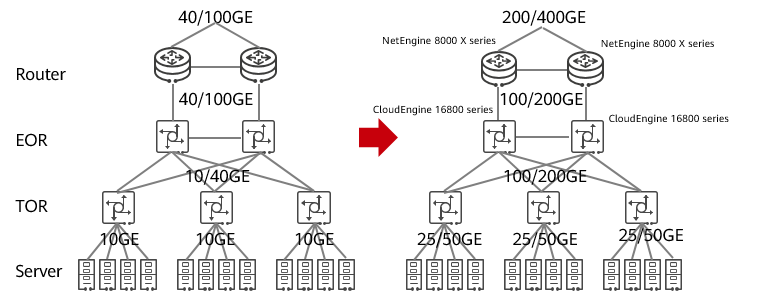What Is PAM4?
PAM4 is a modulation technology that uses four different signal levels for signal transmission. Compared with NRZ signals, PAM4 signals have an additional two levels. This means that, under the same baud rate, the bit rate of PAM4 signals is twice that of NRZ signals, achieving twice the transmission efficiency. With the development of 5G networks, meeting rising bandwidth demands requires more logic information to be transmitted per unit interval (UI). Due to its high transmission efficiency and low construction costs, PAM4 has seen significant uptake in next-generation high-speed signal interconnection. It is now widely used in 50G, single-wavelength 100G, and 400G (non-ZR) optical modules to empower various 5G enterprise networks and carrier networks.
What Is PAM4?
PAM4 is a popular modulation technology that uses four different signal levels for next-generation high-speed signal interconnection. PAM4 signals have two more levels than traditional NRZ signals, which use high and low signal levels to represent 1 and 0 of a digital logic signal. NRZ can only transmit 1 bit of information per signal symbol period. In contrast, PAM4 signal uses four different signal levels — 00, 01, 10, and 11 — to transmit signals, meaning it can transmit 2 bits of logic information per signal symbol period. In this way, compared with NRZ, PAM4 doubles the bit rate for a given baud rate.
Why Do We Need PAM4?
TeleGeography reported that the global bandwidth market is still growing rapidly, posing higher requirements on the signal transmission capability of existing network technologies and network infrastructure. Against this backdrop, traditional NRZ signals encounter bottlenecks in transmission efficiency. This is where PAM4 comes into play. PAM4 combats the drawback of NRZ signals in terms of low signal transmission efficiency. It meets increasing bandwidth requirements while also maintaining a low construction cost, making it the most cost-effective solution.
High cost-effectiveness: For an optical module, there are two methods to improve its transmission rate: increasing the quantity of signal transmission channels and increasing the rate of each channel. The former involves excessive construction costs, making the latter the better solution. Offering more signal levels, PAM4 achieves higher transmission efficiency for a single channel per UI. While ensuring that the number of channels and existing optical components remain unchanged, PAM4 doubles the network interface rate by upgrading the internal electrical chip of the optical module. Fortunately, the existing network control chips (for example, X86 chips) and the intra-board or inter-board interfaces (for example, SerDes interfaces) of high-end devices are able to process PAM4 signals.
Mature technology: The IEEE 802.3bj standard for 100G backplanes issued in 2014 defines two signal transmission modes: NRZ signals with 4 x 25.78 Gbit/s baud rate and PAM4 signals with 4 x 13.6 Gbit/s baud rate. With the development of chip, PCB, and connector technologies, NRZ technology was quickly put into commercial use. PAM4, on the other hand, was not used in 100G Ethernet due to its lack of technology maturity and high cost. During the formulation of the 200G/400G interface standard, the common requirement is to increase the data rate of each pair of differential lines to 50 Gbit/s or higher. If NRZ technology is still used, the time margin requirement for a transceiver chip and transmission link will become stricter because each symbol period is less than 20 ps. In this context, PAM4 emerges as the best option.
What Are the Advantages of PAM4?
The rapid development of information and network technologies has raised higher requirements on information transmission. PAM4 stands out with its high transmission efficiency and low construction costs, making it the go-to option for next-generation high-speed signal interconnection.
High transmission efficiency: Because a PAM4 signal has two more levels than an NRZ signal in signal transmission, the bit rate of a PAM4 signal is twice that of an NRZ signal given the same symbol period. This results in PAM4 having higher transmission efficiency. In other words, at the same bit rate, the baud rate of a PAM4 signal is only half that of an NRZ signal, significantly reducing the signal loss in a transmission channel. In short, PAM4 has greater advantages in terms of improving signal transmission efficiency and reducing the signal transmission loss.
Low construction costs: PAM4 signals have a higher bit rate. On 5G transport networks, PAM4 can achieve higher transmission efficiency by using fewer mature optical components, without the need for extra optical fiber devices. This drastically reduces construction and R&D costs.
What Are the Disadvantages of PAM4?
Although PAM4 signals can transmit more logic information than NRZ signals in the same symbol period, as can be seen in the eye diagrams of PAM4 and NRZ signals, PAM4 signals have smaller eyes and therefore are more vulnerable to interference from external environments (especially noises). Due to this instability, PAM4 signals perform less well in terms of transmission distance and heat dissipation.
Short transmission distance: PAM4 signals are more susceptible to interference from external environments. This results in a higher bit error rate (BER) over long transmission distances. Therefore, amplifiers and forward error correction (FEC), among others, are required to ensure the stability and correctness of signal transmission when the transmission distance exceeds 5 km.
Greater heat dissipation required: Compared with NRZ signals, PAM4 signals require more auxiliary devices to ensure the stability and correctness of signal transmission over a long distance. This means more power consumption, causing the transceivers at both ends of each link to generate more heat. For this reason, radiators may be required when PAM4 is used.
Where Is PAM4 Used?
As data communication technologies continuously mature, 50G, single-wavelength 100G, and 400G (non-ZR) optical modules are typical components that use PAM4. So, it is found in various routers and switches, for example, Huawei NetEngine 8000 X series, F series, M series, and ATN series routers, as well as CloudEngine 16800 series switches. The following describes how PAM4 is applied in different network scenarios.
5G Mobile Transport Network
eMBB, URLLC, and mMTC services place greater demands on the bandwidth of 5G transport networks. Compared with 4G, 5G improves the spectral efficiency by three to five times. The spectrum width of 5G starts from 100 MHz, five times higher than that of the early stage of 4G. The bandwidth of sub-6GHz increases by 15 to 25 times compared with that of 4G. The high-frequency spectrum of 5G can reach over 800 MHz, and the capacity also increases. According to the bandwidth assessment method proposed by the Next Generation Mobile Networks (NGMN) Alliance, the transport network bandwidth of 5G will evolve to 50GE/200GE at the stage of sub-6GHz deployment, as shown in Figure 1-2. At the high-frequency stage, the end-to-end bandwidth will evolve to 100GE/200GE/400GE. Such high-bandwidth networks will be underpinned by PAM4 thanks to its efficient signal transmission.
Metro Fixed Network
A metro network is used to connect hosts, databases, and LANs in different places across a city. It is a high-bandwidth, multi-function, and multi-service multimedia communication network that integrates data, voice, and video services. The interface bandwidth of such a network directly determines how well network services run. PAM4 can help expand the capacities of these interfaces (including those at the core layer and aggregation layer), improving information transmission efficiency of the entire network, providing optimal network experience for LANs and mobile terminals on the metro network, and guaranteeing bandwidth to support the development of communication services in the metro system.
Current mainstream interfaces of metro fixed networks are 10GE and 40GE interfaces. With the rapid development of HD, 4K, 8K, and VR/AR, such network interfaces will soon evolve to 50GE, 200GE, or even 400GE, as shown in Figure 1-3.
DCI or DCN
The working efficiency of a DCI or DCN depends greatly on the running efficiency of switches and routers. The data conversion and transmission capabilities of switches and routers can be improved using high-performance optical modules. PAM4-encoding chips used in optical modules can convert NRZ signals into PAM4 signals, increasing the amount of information processed by switches and routers, compressing the space occupied by signals, and better supporting the functions related to the first three layers (physical, data link, and network layers) in the OSI reference mode. This makes PAM4 further empowers the DCI scenarios, such as cross-region operations, user access, and remote disaster recovery scenarios.
Using 50G PAM4 as an example, the rapid development of DCs drives the upgrade of server interfaces, DCN interfaces, and DCI interfaces from 10GE/40GE interfaces to 50GE/200GE/400GE interfaces, as shown in Figure 1-4.
- Author: Huang Hefei
- Updated on: 2023-04-18
- Views: 4925
- Average rating:












